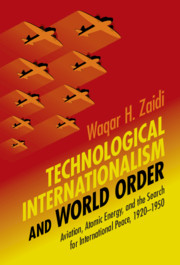 Technological Internationalism and World Order
Technological Internationalism and World Order Aviation, the League of Nations, and the Transformation of World Order
Published online by Cambridge University Press: 25 May 2021
Chapter Three argues that British thinking on aviation and internationalization became radicalized in the early thirties, and remained so until the onset of the Second World War. By the start of the decade, scientific disarmament was no longer enough for internationalists. They now pushed for a more comprehensive aerial transformation of international relations. The 1932 Geneva Disarmament Conference, and internationalist organizations such as the League of Nations Union and the New Commonwealth Society, emerged as sites for the discussion and propagation of these aerial visions. Arguments about the convertibility of civilian to military aviation were used to make the case for comprehensive international control of both military and civilian aviation. In the most radical proposals existing airlines and air forces were to be transferred to the League of Nations, which was to run them and use them to ensure international peace and security. By the mid-thirties, as the fascist threat loomed large, there emerged a more muscular internationalism willing to use bombing to bolster the fledgling League order. A central argument in this chapter is that these proposals were not simply a response to the rise of German aviation or fear of bombing but instead reflected a national enthusiasm for aviation, as well as British aerial and scientific might.
To save this book to your Kindle, first ensure [email protected] is added to your Approved Personal Document E-mail List under your Personal Document Settings on the Manage Your Content and Devices page of your Amazon account. Then enter the ‘name’ part of your Kindle email address below. Find out more about saving to your Kindle.
Note you can select to save to either the @free.kindle.com or @kindle.com variations. ‘@free.kindle.com’ emails are free but can only be saved to your device when it is connected to wi-fi. ‘@kindle.com’ emails can be delivered even when you are not connected to wi-fi, but note that service fees apply.
Find out more about the Kindle Personal Document Service.
To save content items to your account, please confirm that you agree to abide by our usage policies. If this is the first time you use this feature, you will be asked to authorise Cambridge Core to connect with your account. Find out more about saving content to Dropbox.
To save content items to your account, please confirm that you agree to abide by our usage policies. If this is the first time you use this feature, you will be asked to authorise Cambridge Core to connect with your account. Find out more about saving content to Google Drive.